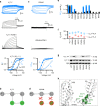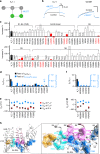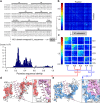Two-stage electro-mechanical coupling of a KV channel in voltage-dependent activation
- PMID: 32015334
- PMCID: PMC6997178
- DOI: 10.1038/s41467-020-14406-w
Two-stage electro-mechanical coupling of a KV channel in voltage-dependent activation
Abstract
In voltage-gated potassium (KV) channels, the voltage-sensing domain (VSD) undergoes sequential activation from the resting state to the intermediate state and activated state to trigger pore opening via electro-mechanical (E-M) coupling. However, the spatial and temporal details underlying E-M coupling remain elusive. Here, utilizing KV7.1's unique two open states, we report a two-stage E-M coupling mechanism in voltage-dependent gating of KV7.1 as triggered by VSD activations to the intermediate and then activated state. When the S4 segment transitions to the intermediate state, the hand-like C-terminus of the VSD-pore linker (S4-S5L) interacts with the pore in the same subunit. When S4 then proceeds to the fully-activated state, the elbow-like hinge between S4 and S4-S5L engages with the pore of the neighboring subunit to activate conductance. This two-stage hand-and-elbow gating mechanism elucidates distinct tissue-specific modulations, pharmacology, and disease pathogenesis of KV7.1, and likely applies to numerous domain-swapped KV channels.
Conflict of interest statement
J.S. and J.C. are cofounders of a startup company VivoCor LLC, which is targeting
Figures






Similar articles
-
KCNE1 remodels the voltage sensor of Kv7.1 to modulate channel function.Biophys J. 2010 Dec 1;99(11):3599-608. doi: 10.1016/j.bpj.2010.10.018. Biophys J. 2010. PMID: 21112284 Free PMC article.
-
KCNQ1 channels voltage dependence through a voltage-dependent binding of the S4-S5 linker to the pore domain.J Biol Chem. 2011 Jan 7;286(1):707-16. doi: 10.1074/jbc.M110.146324. Epub 2010 Oct 12. J Biol Chem. 2011. PMID: 20940310 Free PMC article.
-
KCNE1 constrains the voltage sensor of Kv7.1 K+ channels.PLoS One. 2008 Apr 9;3(4):e1943. doi: 10.1371/journal.pone.0001943. PLoS One. 2008. PMID: 18398469 Free PMC article.
-
Voltage-Dependent Gating: Novel Insights from KCNQ1 Channels.Biophys J. 2016 Jan 5;110(1):14-25. doi: 10.1016/j.bpj.2015.11.023. Biophys J. 2016. PMID: 26745405 Free PMC article. Review.
-
KCNQ1 channel modulation by KCNE proteins via the voltage-sensing domain.J Physiol. 2015 Jun 15;593(12):2617-25. doi: 10.1113/jphysiol.2014.287672. Epub 2015 Feb 16. J Physiol. 2015. PMID: 25603957 Free PMC article. Review.
Cited by
-
Polyunsaturated Fatty Acids as Modulators of KV7 Channels.Front Physiol. 2020 Jun 11;11:641. doi: 10.3389/fphys.2020.00641. eCollection 2020. Front Physiol. 2020. PMID: 32595524 Free PMC article. Review.
-
Evaluating sequential and allosteric activation models in IKs channels with mutated voltage sensors.J Gen Physiol. 2024 Mar 4;156(3):e202313465. doi: 10.1085/jgp.202313465. Epub 2024 Jan 31. J Gen Physiol. 2024. PMID: 38294435 Free PMC article.
-
Isothermal Titration Calorimetry for Fragment-Based Analysis of Ion Channel Interactions.Methods Mol Biol. 2024;2796:271-289. doi: 10.1007/978-1-0716-3818-7_16. Methods Mol Biol. 2024. PMID: 38856907
-
Origin of acetylcholine antagonism in ELIC, a bacterial pentameric ligand-gated ion channel.Commun Biol. 2022 Nov 18;5(1):1264. doi: 10.1038/s42003-022-04227-6. Commun Biol. 2022. PMID: 36400839 Free PMC article.
-
Modulation of the IKS channel by PIP2 requires two binding sites per monomer.BBA Adv. 2023 Jan 7;3:100073. doi: 10.1016/j.bbadva.2023.100073. eCollection 2023. BBA Adv. 2023. PMID: 37082259 Free PMC article.
References
Publication types
MeSH terms
Substances
Grants and funding
LinkOut - more resources
Full Text Sources

